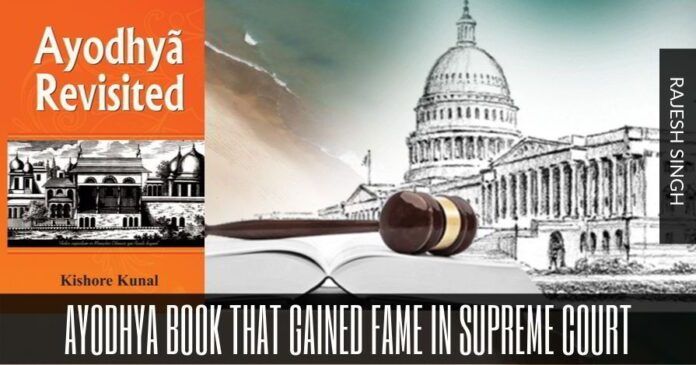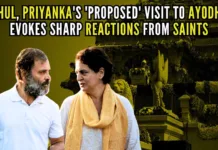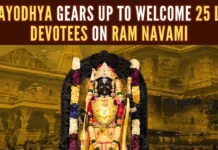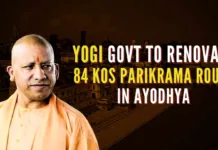
The author takes on the Left-liberal historians with gusto in the chapter, with a palaverous title, ‘Aligarh Historians’ Contumelious Criticism of the Ayodhya Verdict’
A copy of the pictorial map showing the birthplace of Lord Ram, which a senior counsel for the Muslim side dramatically tore up in the court presided over by a Bench headed by the Chief Justice of India on October 16, forms part of a book written by Kishore Kunal. Who is this author and what is his book about?
Kishore Kunal is a former India Police Service (IPS) officer who served as an officer on special duty (OSD) in the Union Ministry of Home Affairs during 1989-1990. He was tasked with facilitating and coordinating negotiations on the Ayodhya dispute between the warring parties and had worked under the administrations of Prime Minister VP Singh and Chandrashekhar. He was, thus, an insider into the affairs of the vexed issue. Kunal also holds a postgraduate degree in History and Sanskrit and was Vice-Chancellor of KSD Sanskrit University in Darbhanga. He retired from the IPS in 2001 and has since then engaged himself in various academic endeavours, including authoring books.
The map in the eye of controversy forms part of his book titled, Ayodhya Revisited, published in 2016. The book has a foreword by former Chief Justice of India GB Patnaik, who wrote that Kunal deserved “commendation for his in-depth study and scientific analysis on which he has based his conclusions”. The former justice added that the author, while dealing with the subject of the existence of a temple at the birthplace of Lord Ram, had relied on a range of literary sources culled from accounts of foreign travellers, besides the archaeological reports. Justice Patnaik said, “The scientific basis and the authentic sources of information on the basis of which the conclusion has been arrived at establish how the historians were erroneous and it is not merely a belief of Hindus; rather clinching materials establish the fact that there existed a temple.”
The author takes on the Left-liberal historians with gusto in the chapter, with a palaverous title, ‘Aligarh Historians’ Contumelious Criticism of the Ayodhya Verdict’.
The book itself is a voluminous work, running into more than 700 pages. Perhaps no other work on this subject has delved deeper into ancient texts and writings by travellers who either visited Ayodhya or had the chance to study it closely. Interestingly, the author had dedicated the book to five foreigners — an Austrian Jesuit priest, an English merchant, A Dutch geographer, a British traveller and a French scholar — whose “compact writings are eloquent testimony to many momentous events of the holy city”.
Kunal cites eleven documents that he considers as of great importance on the Ayodhya dispute. One, the Ayodhya Mahatmya of Rudra Yamala; Satyopakhyanam; the Vishnu-Hari inscription; Dutch writer Joannes De Laet’s book in Latin, De Imperil Magni Moguls Sive India Vera Commentarius (1631); Thomas Herbert’s Some Yeares Travels into Divers Parts of Asia and Afrique (1634); Joseph Tieffenthaler’s book originally in Latin and later translated into English and published in 1828 as The Modern Travellers; C Mentelle’s 1801 book, Courses of Cosmography (Cosmology), on geography, on Chronology and on ancient and Modern History; a Universal Gazetteer written by JR M’Culloch; a missive in the form of a written complaint made in 1858 by Syed Mohammad Khatibi, then a functionary of the Babri mosque in Ayodhya (Oudh); a book by the then officiating commissioner of Faizabad (1870), P Carnegy; and, the Ayodhya Sanad (July 8, 1723). The common factor in all these writings is a reference to a temple at the site in Ayodhya which is now disputed and awaiting a Supreme Court verdict.
Kunal’s book goes deep into available material, largely from ancient days, to build his narrative, which is then supplemented by archaeological and other scientific evidence. The author, in a telling message to all those Left-liberal historians who have over the decades sought to distort material to suit their convenience and rubbished evidences produced by the other side as mere concoctions, quotes the following lines of BR Ambedkar: “As has been well said, a historian ought to be exact, sincere, and impartial; free from passion, unbiased by interest, fear, resentment or affection; and faithful to the truth, which is the mothproof history, the preserver of great actions, the enemy of oblivion, the witness of the past, the director of the future. In short, he must have an open mind, though it may not be an empty mind, and readiness to examine all evidence even though it is serious.”
The author takes on the Left-liberal historians with gusto in the chapter, with a palaverous title, ‘Aligarh Historians’ Contumelious Criticism of the Ayodhya Verdict’. Referring to the Aligarh Historians Society’s criticism of the Allahabad High Court’s 2010 verdict on the issue in a booklet published by the Safdar Hashmi Memorial Trust (SAHMAT), he says, “After going through the same, I found that the booklet is bristling with factual errors and flawed arguments.” Taking a jibe at the historians’ argument that the Austrian priest who had visited Ayodhya had made no mention of Hindus inscriptions, Kunal said the same historians were also arguing that Tulsidas had made no mention of the destruction of a temple at the site in Ayodhya. If non-mention in one place is evidence of one kind, how can non-mention in another place be evidence of another, opposing kind!
In any case, as the author points out, the Gazetteer of the Province of Oudh, edited by WC Bennet in 1877, stated: “It is locally affirmed that at the Muhammadan conquest there were three important Hindu shrines… at Ayodhya, which was then little other than wilderness. These were the Janmasthan, the Swargddwar mandir, also known as Ram Durbar, (and) Treta-ka-Thakur.” On the first of these, Emperor Babur builds the mosque, which still bears his name…”
Kishor Kunal observes, in concluding his book, that “no amount of canard and contrived history will dilute the status of Rama as Maryadapurushottam in this country”.
Note:
1. The views expressed here are those of the author and do not necessarily represent or reflect the views of PGurus.











Senior counsel my foot…
# Tearng the book in the SC, ought not to have been done. That too, of the likes of the said Senior Counsel. It’s my own opinion.